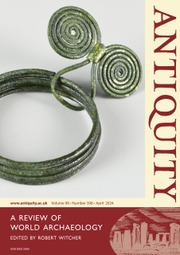Article contents
The Function of the Yoke Saddle in Ancient Harnessing
Published online by Cambridge University Press: 02 January 2015
Extract
Dr Watson's review of Dr von Dewall's Pferd und Wagen im Frühen China in your June issue raised a very interesting question, a hitherto unexplored aspect of which is indicated, if never developed, in the book.
Dr Watson writes that the author ‘Rather surprisingly, sees no problem in the perennialquestion of the plac—hest or neck—on which the yoked horses took the load, and assumesthat the system of traces kept the point of draught low and protected the horses from thechoking effects of a band around the neck.’ Dr von Dewall referred to a girth (Bauchgurt)rather than to traces (which did not then exist) as performing this function, but wasover-optimistic in believing it could be successful. But she does assign a role, although a notentirely correct one, to the yoke saddle: ‘Die Jochgabel auf dem Nacken der Pferde, an derein Brustblatt angesetzt haben muss, das von Brust und Schulter die Zugkraft abnahm, wardamit ein wichtiges Verbindungsglied in diesem Zugsystem’ . The saddle is an element of theharness long neglected in the literature and, although it could never completely have removed the pressure from the throat (‘breast’ is a euphemism), I hope to demonstrate that itwould permit the withers and particularly theupper shoulder to absorb some of this-at leastwhen the horse was in certain positions.
Information
- Type
- Research Article
- Information
- Copyright
- Copyright © Antiquity Publications Ltd 1968
References
page 27 note * I am indebted to Professor J. K. Anderson, with whom I first discussed this matter, for his interest and for his helpful comments.
- 7
- Cited by

